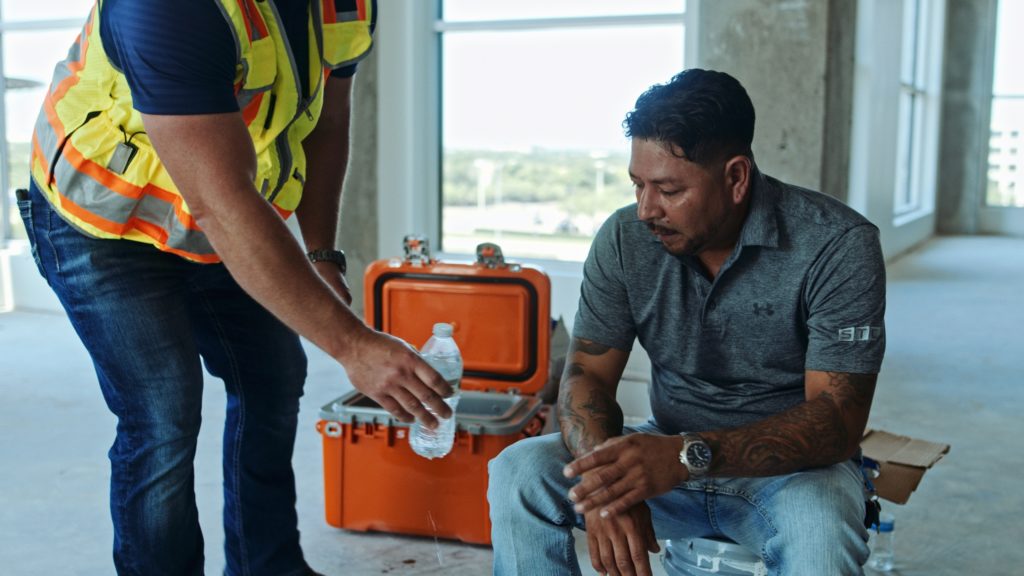
Heat illnesses like heat stroke and exhaustion should not be taken lightly. As roofers, our daily exposure to heat is a significant risk. Roofs, with their ability to absorb heat, can reach temperatures up to 170° F, surpassing the outside temperature. This means that you’re still at risk even if you’re not working directly under the sun. However, the good news is that heat-related illnesses are preventable. Here are some essential tips for keeping yourself healthy and preventing summer heat illnesses!
Types of Heat Illnesses
Heat cramps
Heat cramps are often the first sign of heat illness, resulting in dehydration and a lack of electrolytes. Painful muscle spasming or cramping, usually in the arms, legs, and abdomen, is the most obvious sign of heat cramps and excessive sweating.
Heat Exhaustion
If you are experiencing heat exhaustion, your body is overheating and cannot properly cool due to a lack of salts and fluids. Someone with heat exhaustion will exhibit excessive sweating, dizziness, fatigue, nausea, and headache. The excessive sweating associated with heat exhaustion is especially problematic because the body is already dehydrated and cannot replace the fluids lost through sweating, worsening the condition.
Heat Stroke
Heat stroke is the most serious form of heat illness, arising from untreated heat exhaustion or independently.
When heat stroke occurs, the body has overheated to the point where the organs malfunction and shut down. The brain swells, the intestines become more permeable, and the blood vessels dilate, causing blood pressure to drop. On the outside, a person experiencing heat stroke will display a fever, dry and hot skin, nausea and vomiting, dizziness, confusion, agitation, and lethargy.
Extreme cases might even result in seizures or a coma. Note that once a person has reached the heat stroke level, they stop sweating excessively and show dry, hot skin. This is because the body has become dehydrated to the point where it can no longer produce sweat to cool itself down, and it marks a significant progression from heat exhaustion to heat stroke. If you or someone else is experiencing a heat stroke, call 911 immediately, start cooling that person down with water and ice, and remove unnecessary clothes.
Signs Of Heat Illnesses
There are common signs and symptoms to watch while working in extreme heat conditions.
- Cramps and fatigue
- Headaches
- Nausea
- Weakness or dizziness
- Heavy sweating or hot, dry skin
- Elevated body temperature
- Thirst
- Decreased urine output
If you or someone you see are experiencing these symptoms, take action by:
- Give them water to drink
- Move them to a cooler area
- Cool them with water, ice, or a fan
- Remove unnecessary clothing
- Do not leave them alone
- If in doubt, call 911 or seek medical care
Tips to Prevent Heat Illnesses
- Drink water before, during, and after work. Avoid energy drinks or sodas while working in the heat or direct sun, as these can quickly dehydrate you.
- Take your break in the shade or cool area. Find a cool, air-conditioned, or shaded area on lunch and breaks. If someone or yourself is beginning to experience heat exhaustion or cramps, it’s a good time to take a break to cool off and rehydrate!
- Dress appropriately for the heat. Even if the morning is cooler, wear layers that you can take off for warmer afternoons!
- Understand your risks when it comes to heat! Working indoors and outdoors can put you at risk for heat illnesses.
Now that you know the signs and symptoms of heat illnesses, you can better prevent them at work. Watch out for yourself and your crew members during these summer months!
Resources:
Foster, K. (2019, June 19). Heat Illness Prevention: Keeping Your Roofing Crews Safe. AccuLynx. https://acculynx.com/keep-your-roofing-crew-safe-from-heat-illness/
Prevent Heat Illness at Work Ways to Protect Yourself, and Others Ease into Work. Nearly 3 out of 4 fatalities from heat illness happen during the first week of work. (n.d.). https://www.osha.gov/sites/default/files/publications/3431_wksiteposter_en.pdf